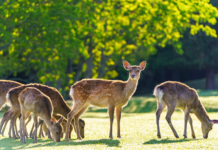By Chris Markham
Landscape professionals know there are few obstacles more difficult to deal with than deer control. According to the Quality Deer Management Association, just a single 150 pound white-tailed deer will eat anywhere between 9 to 12 pounds of vegetation per day. On a landscaped lawn, that can mean lots of aesthetic and financial damage, a greater risk for ticks, and unhappy clients. So how do you control deer?
Now more than ever, deer have been observed eating plants considered for decades as “deer-resistant.” Green giant arborvitae, coneflowers, and astilbe are just a few of the commonly used landscape plants that deer have taken a liking to in recent years. While no one knows for sure why deer are expanding their palates, there are some obvious trends in deer populations that provide some clues.
For one, overdevelopment has limited their wild habitat and forced them to find food on residential properties. Deer don’t seem to mind suburban habitats which often contain lush, irrigated plantings in a safe environment. In some areas, the densest deer populations are found right in the middle of communities. Another reason is that even in wild areas, high deer populations have decimated native understories — only to be replaced by inedible invasive species such as Japanese barberry and Japanese stiltgrass.
No Hosta, Daylily Or Yew

So what should landscape professionals plant if deer are around? First, avoid anything that deer consider a preferable food. This would include hostas, daylilies, and yews. It is important to communicate upfront to clients that planting such deer-preferred species is only setting themselves up for failure. Deer are creatures of habit. Once they find a food source, they are likely to come back every day until it’s gone.
Though no deer resistant plant is fool-proof, planting less preferred food options provides a greater chance of keeping plants alive and customers happy. Some common and attractive landscape plants deer tend to avoid include yarrow, allium, milkweeds, fragrant lavender, and soft lamb’s ear. Deer very rarely eat these due to their scent, toxic components, or texture.
Plant Alternatives
By doing a little research and making smart choices, landscapers can often find a deer-resistant plant with similar growing habits that is a satisfactory alternative to more commonly used plants.
For example, people often love liriope grass along the front of their beds. Unfortunately, so do the deer. One option is to plant sedges (Carex) in their place. Another example is the weeping cherry tree. This popular landscape tree is a deer favorite, often seen stripped of their foliage at the “browse line,” around five feet and down. An easy replacement is the weeping birch or weeping beech. Making these simple replacements will provide better long-term benefits.
Repellents, Fencing & Bed Design

Of course, sometimes a customer really likes a particular species of plant, or there are existing landscape plantings the owner wants to retain. There are a couple options to keep the deer away. A variety of deer repellents exist with varying degrees of effectiveness. Talk to others in your area to gauge what works. But keep in mind it’s always a good idea to rotate products because deer can adapt to a particular scent or taste over time. Landscapers can also outsource the job to professional deer control companies that typically carry their own products.
Naturally, another option is to use fencing. A nine-foot fence around the entire property is the most fool-proof method to keep deer away, but it’s obviously not an option for everyone. Deer have relatively poor depth perception and are a prey species. They tend to avoid jumping into tight areas where there is no clear route of escape. Take advantage of this by using low fencing around foundation beds. For beds in the yard, try combining raised beds with a short fence. Not a lot of height is needed if the bed is narrow enough. A solid fence, especially on a perimeter, is another option. If a deer cannot see the landing area, it often discourages them from jumping the fence out of fear of injury.
At the end of the day, deer are a natural part of our ecosystem. Just like compensating for cold temperatures in northern states, deer should be a consideration in plant selection where populations are high.
Markham is a wildlife biologist and president of New Jersey Deer Control®, LLC.











![[VIDEO] Dickies®: Discover Workwear That’s Anything But Uniform](https://turfmagazine.com/wp-content/uploads/2023/06/1647663814-4b1a2a7742790a9b1e97a3b963477850192e1d6a9dfba9b07214a77bae25d6e3-d-218x150.jpg)





























![[VIDEO] Dickies®: Discover Workwear That’s Anything But Uniform](https://turfmagazine.com/wp-content/uploads/2023/06/1647663814-4b1a2a7742790a9b1e97a3b963477850192e1d6a9dfba9b07214a77bae25d6e3-d-324x160.jpg)